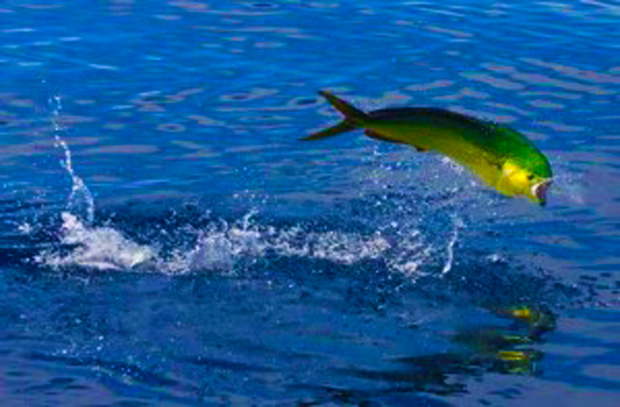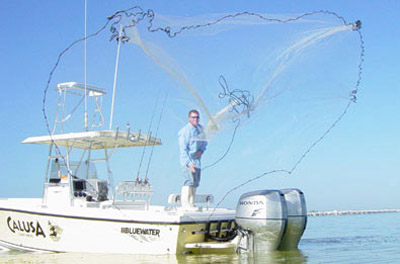By the editors
[dropcap]W[/dropcap]hen fly fishing offshore, bring a frozen bag of chum. When it starts to stink, you’re good to go. And don’t forget the chum bucket. Also, bring a light spinning outfit along with some squid pieces. As far as live baits go, catch your own with a Sabiki set-up or throw a cast net, but if you don’t how, buy some live baits. The better tackle shops and marinas that dock a lot of fishing boats usually have live baits, frozen chum bags and even menhaden fish oil. Also, bring along a stout spinning rod as well as a few hook-less plugs for bait and switch or to catch a dolphin with plugs or lures that have hooks. A dolphin pod will stay put for a long time when a bro is hooked and kept in the water.
Cutting up bait into little strips is labor intensive, dirty business and boring. The preferable way to do that is to buy and mount a 12 volt chum grinder – that way you’ll be a real MacDonald’s for game fish. Don’t forget, the idea is to let them “wet their beaks,” not feed them. When the fish are “up” you can throw some bigger chunks of bait or live baits to get them really fired up. Even doubting Thomas’ mangrove and gray snappers will come off the bottom and feed as will yellowtails.
All species of macks (Spanish, king and cero), blues, stripers and even cobia go a little bit catnip-stupid when a slick of chum or baits are presented. Once you’ve started a slick, slow your boat down or still fish with a current running away from the transom. Some captains like to make large circle routes at inlets, letting the fragrance do its work. Again, if macks are around – they’ll find you. You’ll need current to be effective with chum. If you’re at an inlet and it’s slack tide nothing is going to happen. However, beach-side and further off shore, no matter the tide, there should be current – find it.
Here’s trick a New Jersey captain told us about. In your chum bucket put dry dog food and mix in about a cup or more of menhaden oil. Mix ingredients well and serve cold via your chum bag.
Designed and tied specifically for kings, the flies shown above have turned out to have universal game fish attractor appeal for offshore big boys game fish. They were tied and photographed by Grant Gisondo, a boating contributor to this publication. He’s also an avid fly angler with a nice 28-foot console and loves to go after kings. Here’s what he had to say about flies, rods and reels when king-mack fishing.
Going for big “smokers kings”
[information]
By Grant Gisondo
“I highly recommend using a 9- up to 12-weight fly rods and it is an absolute must that you own a high quality fly reel that has a smooth, strong drag. Kings can literally make your reel smoke. Their power and speed are unbelievable – thus they’re called “smoker kings.” Typically, I carry two rods, a 9- and a 10-weight which serves two needs. I have a back up in case a rod breaks and if the size of the fish schools change, I’m ready. I also recommend full, fast sinking fly line matched to the weight of the fly rod. This will help keep your fly in the strike zone. Intermediate lines, although great for surf casting, do not sink fast enough with a drifting boat to keep your fly in the target zone of 50-80 feet.
Big flies I’ve found that kingfish prefer flies from 6- to 8-inches long. I prefer to tie my own kingfish flies and use Super Hair tied on Eagle Claw 254 SS 3/0 hooks. The most productive colors are pink and white, chartreuse and white, and all white. The flies need some flash, but less is better than more.
Two trademarks of a good kingfish fly are large dome eyes and solid epoxy heads which aid in getting the fly to sink quickly.”
To read full story click here […]
Grant’s website – click here […]
[/information]
Some common baits Florida, Bahamas and Caribbean

Ballyhoo and balao are easily differentiated: ballyhoo have a shorter upper jaw and the tip of its lower jaw is orange-red. For fly anglers they’re are best for teasing in bill fish. Best to buy frozen.
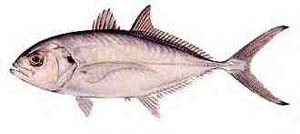
A blue runner can get to be over 2-feet long and weigh in at 12-pounds. It’s a great fish fight on light tackle, readily taking a fly or lure. Catch a couple and you’ll have chum bait to spare.
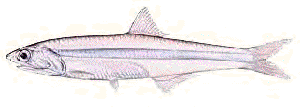
Glass minnows are sardines (silversides) that are transparent with a broad silver stripe down the side. Seldom over 3-inches long. Extremely abundant and widespread – found all the way from Maine to Caribbean. Excellent chumming bait. Cast netted only.

Menhaden are always in fast moving schools and they won’t bite a hook (plankton feeder) so they must be netted. Up to 15-inches long.

Pinfish appeal to a great many game fish species. They’re easy to catch – bait a #2 or #4 hook with squid and toss it over some grassy bottom. A Sabiki set-up works well also. Rarely exceed 8-inches and are most often caught at 5-inches.

Spanish sardines are generally around 10-inches long and are great baits. Their stocks, like mullets, are being decimated by commercial interests. You can net them or use Sabiki gold hook rigs. Found shallow waters.
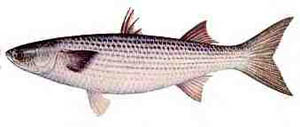
Striped mullet, black mullet and white mullet (fatback). A lot of “Crackers” eat them. Mullets are fit for kings – just about everything else too. They’re 14- to 20-inches long. Mullet are commonly caught using a cast net. In the fall, the mullet run turns everything on from beach to offshore.

Striped mojarra (sand perch, goat, sand brim) are a favorite of almost everything. They can be caught in a cast net – sand bottoms in the surf line or just offshore. Average length is just under 1-foot.
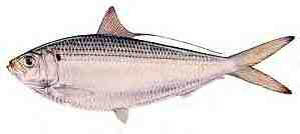
Threadfin herring are Herbivores and don’t respond to chum. They’re 8- to 12-inches and can be netted.
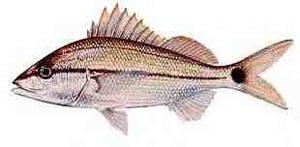
Tomate is about 8-inches long. If you need fresh bait they can be caught on almost any bottom with small hooks baited with squid. Make excellent cut-bait.


